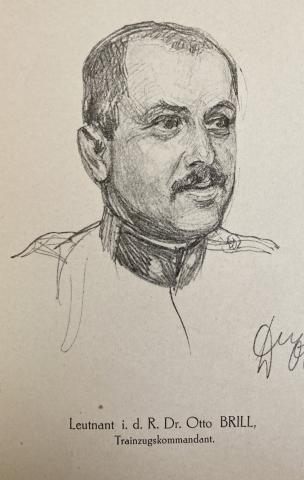Otto Brill, a chemist with a doctorate, was the second oldest of four children of the Jewish leather merchant Mori(t)z Brill and his wife Amalie, née Thein. After his father's death in 1908, Otto was the only son to take over the company, a transmission belt factory, which his father had established ending his scientific career to do so. In 1921, he married Livia Gunszt, called Lilly. The marriage produced three children: Eva Renata, Agathe Annemarie and Hans. In 1923, Otto Brill acquired the property in Vienna's 2nd district at Obere Donaustraße 35, whose bel étage was inhabited by the family. Brill promoted young artists and over the years built up an extensive art collection with a focus on contemporary art. He usually stamped the works of art he acquired with "Sammlung OB" on the back. His interest in modern art and his acquaintance with some artists probably also led him to become a partner in the Würthle Gallery run by Lea Bondi-Jaray. Brill also owned an extensive library, for which he had an ex-libris made by Sascha Kronburg.
Immediately after the annexation of Austria to the German Reich in March 1938, Otto Brill was arrested and his assets seized by the Gestapo. On the basis of the Regulation on the Expropriation of Assets Hostile to the Volk and the State in the Province of Austria, his company and his home were confiscated. He handed over part of his books to the prisoners' library of the Provincial Court for Criminal Matters. The art collection which comprised approximately 400 works and whose export had been applied for also aroused great interest. The Albertina initially acquired three self-portraits by the artists Anton Hanak, Max Slevogt and Anton Faistauer and two Albin Egger-Lienz drawings in July 1938, and at the beginning of August, two sheets each by Rudolf von Alt and Moritz von Schwind as well as a pencil drawing by Carl Spitzweg. The rest of the collection was released for export. In September 1938, the Brill couple managed to escape to London; the children had already fled in June. After the end of the war, the family remained in Great Britain, where Otto Brill established a new existence with Livia Leather Goods Ltd. and founded the St. George's Gallery together with Lea Bondi-Jaray, who had also fled to London. Daughter Eva was the only family member to return to Austria in 1946 and after Brill's death in 1954, she, together with her two siblings, inherited the artworks which had been successfully exported to London. In addition to the restitution of the house and the company, Livia also obtained compensation from the Republic of Austria for Otto's imprisonment. In 2000 and 2002, the Art Restitution Advisory Board recommended the restitution of a total of ten works of art from the Brill Collection that the Albertina had acquired in 1938. In 2023, the Advisory Board decided against the restitution of further works of art from the original property of Otto Brill, which are now in the holdings of the Academy of Fine Arts and the Albertina, as these were works that Brill had been able to take with him to Great Britain and which had been sold by his children through the art trade after his death.

